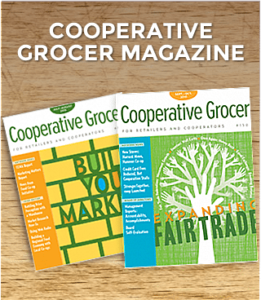
In the back of our minds we knew that
Co-ops are feeling squeezed, and it hurts. Increased competition may limit our profitability but may also limit our local impact. How do we even begin to keep customers happy when chains such as Kroger, Hy-Vee, Target, and Costco can offer the same products for the same or lower prices?
There is a whole new sea of competition that did not exist a few years ago, and it is growing. At CDS Consulting Co-op, we have been working with food co-ops all over North America, helping them prepare for and navigate the new marketplace. Below are some of the most important elements for food co-ops to consider as they learn how to face their new landscape.
Assess your own marketplace
Who are the grocers in your market? Once disregarded, conventional stores’ sales of natural/organic products today exceed total sales in natural food stores. Natural foods chains and conventional stores have to grow to satisfy their investors, and to do that they need our shoppers.
Food co-ops must be diligent if they are to keep their existing customer base, let alone grow it. How is your organization and management team assessing the competition? Regular analysis must be institutionalized within our organizations:
• Monitor how your competitors promote themselves—in print, on social media, at events. Do they promote their prices or other values, or both? How they present themselves affects how you need to shape your image.
• Carry out price comparisons on staple items in every department at least quarterly. That data should drive your pricing decisions.
• Analyze the competition’s products and departments. Where are they strong or weak, and what are they changing at their locations in order to attract more shoppers?
• Determine your best categories to compete in and where to condense your selection. If competing in a category, ensure appropriate selection and pricing in that category. If you need to reduce selection in a category, reduce duplicated products and sizes; then fine tune the “good, better, best” approach so that you have solid value options and not just premium options.
(For more discussion of marketing plans, see the accompanying article by Nicole Klimek and Joy Rust.)
Create a stellar shopping environment
Hit them with your best shot! How does your entry look? Are there old crates and pallets piled up? Your shoppers should be “wowed” by an amazing deal in the first six to eight feet upon entry. We’re not talking about your overstock or leftover holiday sale items. We mean bright, colorful, abundant produce or floral that is fragrant and lush and piled high and adorned with well-branded signs. There should be enough circulation space for shoppers and their carts (about five to six feet usually) as well as functional but nice-looking equipment to house the amazing products. The spike in sales will be worth the extra time needed to plan and maintain the entry.
Make it easy! Most millennial shoppers often don’t have a lot of spare time to wander, looking at all the options and pondering ingredients. They may have only 15 minutes to get dinner and something to tide over the kids in the cart. They look for clear and consistent signage, easy-to-navigate spaces, and products that are at eye level as they rush through each department on their way to the registers.
Fixtures should not be too close or too far away from each other. Perimeter aisles should be at least six to seven feet wide, and interior aisles should be five to six feet for most stores. Calculate it as a cart on each side plus enough room for one person to move past them. If shoppers perceive that the store just isn’t comfortable and easy to get through quickly, they will opt for another grocery.
Be vigilant and intentional in core product mix
Whether by national trends or local influences, our product mix is continually being impacted by outside forces. Enhanced competition does not
always equal contraction, but we must know how to identify and capitalize on opportunities.
How do we know which products or categories to eliminate or add? The first step, again, is to assess the competition to gain a greater understanding of their approach to the market. Does the competition do some things well but not others? Are they good at price but ineffective with fresh foods? Do they have a good wellness set but lackluster grocery offerings? After your team has assessed the competition, work together to list their strengths and weaknesses and develop plans for addressing both.
In the categories where your competition excels, you have two options: enhance your offerings and pricing to fend off potential losses by competing head to head—or reduce your selection in that category, leaving just the basics for convenience.
Utilize category management tools to help you maintain the right competitive mix:
• POS movement reports: Review internal movement reports regularly to understand where you are losing ground and where you remain strong.
• SPINS data: SPINS data, (https://www.spins.com) can enhance knowledge on where you are competitive and where you may need to improve, by comparing your product and category movement to that of competitors in your region.
• Vendor sales data: Knowing your vendors’ top-moving products can give you excellent information on areas where you may have opportunities.
• Information through your broker relationships: Brokers may be able to give you a clearer picture of what your competition does well and where they are lacking. Who else is in so many other stores on a regular basis?
When you do your homework and see that you have opportunity in an area that the competition does not do well, jump on it to ensure your customers see your great selection and price.
Along with product decisions, there needs to be an analysis of all category footprints to determine whether they serve your overall strategy. If you are losing sales in your cereal category, perhaps you need to reduce this category’s footprint by four feet and devote that space to a category in which you want to show strength or in which your research indicates you have a real opportunity. Effectively managing your categories and products in critical areas can maximize your sales and your cash during a challenging time.
Create a price and promotion philosophy and strategy
If you have created a welcoming shopping environment and have done your homework on which products to carry, you now have to think about your overall pricing strategy. Every store has a price image—make sure it is the one you want! You want every shopper to think, “They work hard to offer some good prices all the time, and they have really great specials!” To create that perception, you will need to be knowledgeable and aggressive in your promotion strategies.
Your co-op will also need to create slightly different strategies within each department. The perimeter fresh foods departments need some good values but are going to be noticed mostly by their differentiated products compared to the competition (stunning and fresh organic produce, local meats, and freshly made deli items). However, packaged grocery, refrigerated, frozen foods, and wellness are going to need aggressive competitive strategies since these are the departments with the most similar products at competitor stores and where prices are easily compared.
Smaller retailers such as many food co-ops have to be judicious about how many EDLP (every-day-low-price) items they can offer—yet still need shoppers noticing their good and fair prices. To do this, you will likely need some EDLPs on selected staples all the time and also have an active monthly or weekly promotional plan that fills your endcap displays with great deals all the time. Even if a shopper doesn’t need that promoted endcap item this month, he or she will remember that the co-op always has deals to offer, and that helps shape a positive price perception. Positive perception is essential in the new competitive landscape.
Members of NCG (National Co+op Grocers) have some built-in support in these areas by having access to regular promotional and pricing programs. But even non-NCG members can use this strategy. Your organization just needs to commit to having a two-prong strategy. Hand-select a few basics—say 20 common shopping-list products such as one size of milk, eggs, a juice, a toothpaste, etc.—on which your organization commits to monitoring competitors’ pricing and always staying within 5¬10 percent of their pricing. Then you can add in endcaps with great deals and big signs shouting out those deals
Guidelines for high-impact endcap displays:
• Sale products should be at least 25 percent off the regular price. If you received a 15–20 percent discount from the distributor, consider sacrificing additional margin points to create a truly compelling deal.
• Large clear signage helps all shoppers see that there is a great deal. If you don’t drive sales through your monthly deals, something is wrong. Sale signs should have few words and easy-to-read prices. You are not telling the whole story of the product on an endcap—you are telling someone what a great value it is.
• Limit the number of different promoted products on an endcap to two or three, and try to use products that go together. Cluttered and unthemed endcaps do not draw shoppers in.
• Use color breaks to display promoted products vertically instead of horizontally—such as a top-to-bottom stripe of olive oil in between two tall stripes of red pasta sauce. Color breaks and simple, uncluttered displays slowdown shoppers and help them notice your deals.
Build alignment around strategic goals
To compete in this new landscape, food co-ops must have solid strategic plans and aligned commitment to implement those organization-wide plans. There is no room for department turf wars or petty battles between the sales floor and marketing team. The food co-ops that will survive and thrive in the next decade are the ones who learn to think and act strategically now. Other retail options in your market will drain your loyal shoppers away if everyone in your organization is not pulling together toward the same goals.
Your co-op must create compelling reasons to shop its store and support its long-term goals. This takes coordinated effort to shout out (a) all the ways in which you are different and better than the other options, and (b) that you are sensitive to your shoppers’ needs and work hard to offer competitively priced options.
• Create awareness by talking regularly and honestly with staff about the co-op’s competitive and differentiation goals. Report on the progress of the organization and department goals at staff and management meetings.
• Communicate regularly with your owners—they need to know you value them and are working hard to meet their needs!
• Integrate the marketing team into all discussions and plans. The sales floor cannot create plans in isolation. They need the megaphone of the marketing team to make any strategy work.
• Every department must commit to do its part and do it on time!
Co-ops offer something different in our marketplaces. We have compelling stories and inspiring visions and are dedicated to improving our communities, but we also have to be excellent operators. We can survive and thrive in this sea of competitors, but it will take laser focus and constant and concerted efforts to maintain our roles in our communities.
Co-ops have to shout out the benefits and strengths of our differences, but we also have to shout out that we respect our shoppers’ budgets and are working hard to bring good value into our stores every day. That is a complicated message to deliver, but that is what it will take. A crowded marketplace is the new reality, and food co-ops who want to continue to build stronger local communities have to figure out a way to compete in order to swim in these new waters.
Have more questions?
Get in touch with one of our consultants.


